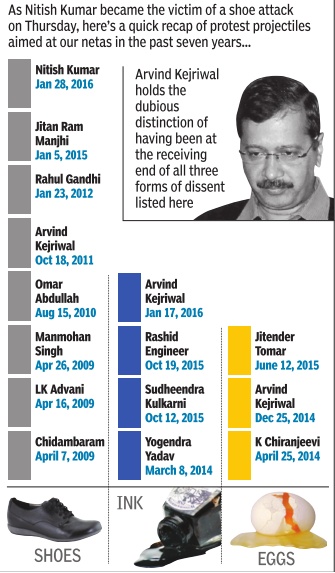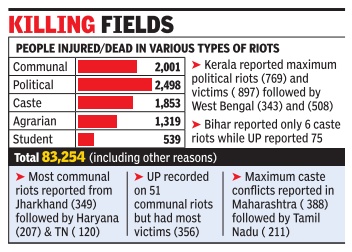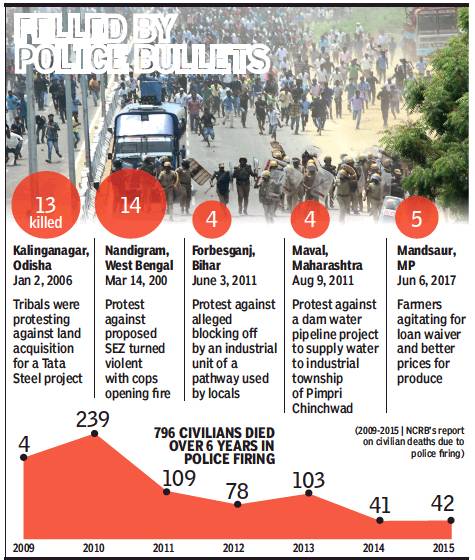Agitations/ protests, political and other: India
This is a collection of articles archived for the excellence of their content. |
Contents |
The legal position
If protesters turn violent, leaders must present themselves to police: SC/ 2018
If protesters turn violent and vandalise property, their leaders must present themselves for questioning at a police station within 24 hours, failing which they will be proceeded against as suspects first and absconders later, the Supreme Court has said.
“In instances where a group or organisation has staged a protest or demonstration resulting in violence and damage to property, leaders and office-bearers should physically present themselves for questioning on their own within 24 hours in the police station within whose jurisdiction the violence and damage occurred,” a bench of CJI Dipak Misra and Justices A M Khanwilkar and D Y Chandrachud said on Monday.
Writing the judgment for the bench, Justice Khanwilkar said, “Any such person(s) failing to present himself or herself in such manner without any sufficient reason should be proceeded against as a suspect and legal process initiated forthwith, including for being declared absconder in accordance with law.”
This will have serious implications, particularly for leaders of fringe groups, as protests over issues like religion, cow protection, films or even political ideologies often turn violent. Turning the screws on such protests, the SC said leaders will be granted bail only if they deposit the estimated cost due to loss or damage, either individually or collectively.
“A person arrested for either committing or initiating, promoting, instigating or in any way causing to occur any act of violence which results in loss of life or damage to property may be granted conditional bail upon depositing the quantified loss caused due to such violence or furnishing security for such quantified loss. In case of more than one person involved in such act of violence, each one of them shall be jointly, severally and vicariously liable to pay the quantified loss,” the SC said.
The three-judge bench fell back on its judgment providing the mechanism to stop lynching incidents and said the nodal officer appointed for each district for curbing such violence would also act to initiate action in vandalism incidents.
“Since the nodal officer (s) holds the overall responsibility in each district to prevent mob violence against cultural establishments and against property, any unexplained and/or unsubstantiated delay in filing FIRs and/or conducting investigations in that regard should also be deemed to be inaction on the part of the said nodal officer(s),” it said.
“The said nodal officer(s) would also be responsible for creating and maintaining a list containing the various cultural establishments, including theatres, cinema halls, music venues, performance halls and centres and art galleries within the district, and pin point vulnerable cultural establishments and property which have been attacked or damaged by mob violence over the past five years.
This list would be updated on a regular basis to account for any new opening and closing of establishments,” it added.
Protesters can’t block roads, public spaces: SC
NEW DELHI: The Supreme Court ruled that authorities, in future, should not permit Shaheen Bagh-type protests involving blocking of roads and public spaces, and said that such expressions of dissent should be organised at designated places without causing inconvenience to the public at large.
Striking a balance between the democratic right to protest and the need to spare people the inconvenience resulting from blockades, a bench of Justices Sanjay Kishan Kaul, Aniruddha Bose and Krishna Murari said staging protests is a constitutional right and emphasised that an issue being sub-judice could not be a deterrent for an agitation on the same. It said pendency of petitions challenging the CAA before the apex court would not take away the right of citizens to protest against its enactment.
However, it also stressed that blockade of public spaces and roads, popular means of protests against colonial rulers, cannot be resorted to in a self-ruled democracy as the Constitution, while conferring certain rights, has also obligated everyone to perform fundamental duties.
"Democracy and dissent go hand-in-hand, but then demonstrations expressing dissent have to be in designated places alone. The present case was not even one of protests taking place in an undesignated area, but was blockade of a public way which caused grave inconvenience to commuters. We cannot accept the plea of the applicants that an indeterminable number of people can assemble whenever they choose to protest," it said.
Writing the judgment for the bench, Justice Kaul said, “Such kind of occupation of public ways, whether at the site in question or anywhere else, for protests is not acceptable and the administration ought to take action to keep areas clear of encroachments or obstructions... We hope such a situation does not arise in future and protests are subject to legal position as enunciated above, with some sympathy and dialogue, but are not permitted to get out of hand.” Referring to the blockade of an arterial road near Delhi's Shaheen Bagh by anti-CAA protesters for months, the bench said while the hand of God in the nature of the Covid pandemic led to dispersal of the protesters, the authorities should act promptly in future.
The blockade of Kalindi Kunj stretch of a busy road continued from December 15 to March 24 when cops got the site cleared following the outbreak. Quoting Pulitzer Prize winner Walter Lippmann’s words — “In a democracy, opposition is not only tolerated as constitutional, but must be maintained because it is indispensable” — the bench said it respects right to peaceful protest of citizens against a legislation, but made it clear that “public ways and spaces cannot be occupied in such amanner and that too indefinitely”.
The bench observed, “We live in the age of technology where the social movements have swiftly integrated digital connectivity into their tool kit, be it for organising, publicity or effective communication.”
Protest within reasonable limits: SC
AmitAnand Choudhary, September 22, 2020: The Times of India
Observing that there is no dispute that citizens have the right to protest, the Supreme Court said right comes with restrictions and a balance has to be maintained between the right to protest and the right to free movement of other people who feel inconvenienced due to blockade of roads.
A bench headed by Justice Sanjay Kishan Kaul agreed with Solicitor General Tushar Mehta's submission that the right to protest is not an absolute right and it is subject to certain restrictions. "Right to protest cannot be an absolute right but there is right to protest," the bench said.
While disposing of a batch of petitions seeking the court's direction for removal of CAA protesters from Shaheen Bagh in the national capital, the bench said it will pass a short order on the basis of its "experiment" in the case to deal with the situation when roads are used for protests. The court had in February appointed senior advocate Sanjay Hegde and advocate Sadhana Ramachandran as interlocutors to persuade the protesters to shift but their efforts were not successful.
The bench said the petitions had become infructuous due to the supervening circumstances as Shaheen Bagh protesters vacated the road due to outbreak of Covid-19 pandemic but added that the larger issue has to be examined. “We are not disputing the right to protest. But it has to be balanced with people's right to free movement. For a long time, the public road was blocked and people were denied movement on the road. The issue is -where and how and how long such protests can go on," it observed.
The petitioners pleaded with the bench that the apex court should frame guidelines so that protests like the one that was organised in Shaheen Bagh, where the agitators squatted on a busy road for months causing inconvenience to people, are not repeated. But the bench said that there cannot be a universal policy for protests.
Advocate Mehmood Pracha, representing some of the protesters, contended that the protest against CAA at Shaheen Bagh was going on peacefully for months but the state machinery was misused to curb movement.
SC: Right to protest can’t be anytime, everywhere
February 14, 2021: The Times of India
SC: Right to protest can’t be anytime, everywhere
New Delhi:
Holding that there cannot be a right to protest “anytime and everywhere” and rights of other people affected cannot be neglected, the Supreme Court has refused to re-examine its Shaheen Bagh verdict in which it had said public roads could not be blocked during the protest.
The SC order comes in the midst of a prolonged protest by farm unions opposed to new farm laws at Delhi borders since November. Residents in these areas have protested barricades and restrictions affecting their movement and livelihoods. A bench of Justices Sanjay Kishan Kaul, Aniruddha Bose and Krishna Murari said there may be some spontaneous protests at public places but there could not be continued occupation of a place by protesters. It dismissed the review petition of a Shaheen Bagh resident, Kaniz Fatima, and others seeking review of the October 7 verdict.
Prolonged protest can’t affect others’ rights: SC
We have considered the earlier judicial pronouncements and recorded our opinion that the constitutional scheme comes with a right to protest and express dissent but with an obligation to have certain duties. The right to protest cannot be anytime and everywhere. There may be some spontaneous protests but in case of prolonged dissent or protest, there cannot be continued occupation of public place affecting the rights of others. Accordingly, the review petition is dismissed," the court said .
The court dismissed the review petition of one Shaheen Bagh resident Kaniz Fatima and others seeking review of last year’s verdict of October 7. The top court also refused the plea to grant open court hearing on its review plea.
While recognising the citizen’s right to protest, the apex court , however, had held public spaces cannot be occupied indefinitely and demonstrations expressing dissent have to be in designated places alone. It had said that pleas of demonstrators that they can assemble whenever they choose to protest cannot be accepted. “Democracy and dissent go hand in hand, but then the demonstrations expressing dissent have to be in designated places alone,” it had said.
Year-wise trends
Political agitations, 1973-2015

See graphic:
Political agitations, 1973-2015
Police firing on civilians/ 2004-13
Apr 09 2015
In the past ten years, police firing has caused over 2,500 civilian deaths in India while injuring over 4,000 people. The highest deaths were reported in Uttar Pradesh, Andhra Pradesh, Jammu & Kashmir, Maharashtra, Chhattisgarh and Madhya Pradesh. No firing deaths were reported in Goa, Himachal Pradesh, Nagaland, Sikkim and all the UTs except Delhi. In 2013, police firing was in most cases related to riot control (50.4%), anti-extremist and anti-terrorist operations (27.8%), against others (not classified18.1%) and anti-dacoit operations (3.6%).
Attacks on politicians with shoes, ink and eggs, 2009-16

See graphic:
Attacks on politicians with shoes, ink and eggs, 2009-16
2014: Political riots deadlier than communal riots

The Times of India, Aug 20 2015
Deeptiman Tiwary
Claimed 400 more in 2014, reveals NCRB data
Political riots deadlier than communal ones
More people get injured or killed in politica riots than in communal con flagration. According to lat est data released by Nationa Crime Records Bureau (NCRB), in 2014, there were over 2,400 victims of politica violence, while 2,000 people were injured or killed in com munal riots. According to the data most communal incidents were reported from Jhark hand (349) followed by Harya na (201). West Bengal and Ta mil Nadu had over 100 incidents each while Maha rashtra recorded 99 cases.
UP, which witnessed one of the worst communal riots in 2013, recorded only 51 cases last year but had maxi mum number of victims at 356. Maharashtra followed UP closely with 355 victims followed by Jharkhand with 349 victims.
Caste clashes were the third biggest reason for con flicts with over 1,800 people either getting injured or killed in riots on caste lines.Curiously , however, conflicts of Dalits and tribals with upper caste resulted in far lesser injuries and deaths as compared to other inter-caste conflicts.
According to the data, 507 people became victims of riots caused by clashes between people belonging to scheduled castes and tribes and those not from the cate gory . On the other hand, 1,346 people became victims of other caste conflicts.
Most conflicts between Dalits and non-Dalits were reported from Maharashtra with 147 riots and 183 victims.It was followed by UP with 66 cases and 101 victims. Bihar, curiously , recorded no such cases. Maharashtra again led the pack with 241 cases in other caste conflicts category followed by Tamil Nadu with 182 such cases.
2006-17: police firing

From: May 23, 2018: The Times of India
See graphic:
2006-17: Agitations on which police had to fire, leading to the death of civilians
Recovering damages from protesters
2020 Mar: UP’s ordinance
Four days after the Allahabad high court slammed the UP government for putting up hoardings carrying names, pictures and addresses of 57 anti-CAA protesters, and a day after the Supreme Court said there was no existing law to back such an action, the government on Friday empowered itself to recover the cost of property damaged during protests, riots and rallies from the accused by promulgating the ‘UP Recovery of Public and Private Property Ordinance’.
The ordinance was cleared by the state cabinet even as the SC is slated to hear a special leave petition next week challenging the HC order to remove the hoardings.
After large-scale violence in December during anti-CAA protests, the government had served recovery notices on the accused, citing a 2009 SC order. Finance minister Suresh Khanna said that the SC, in reference to writ petition 77/2007, had said in 2009 that a strict law was needed to recover costs if private or public property had been damaged during protests like political rallies, strikes and sit-ins.
“Following that order, we have cleared the ordinance. The next step is to draft the rules for this law which will also be cleared by the cabinet,” Khanna said.
